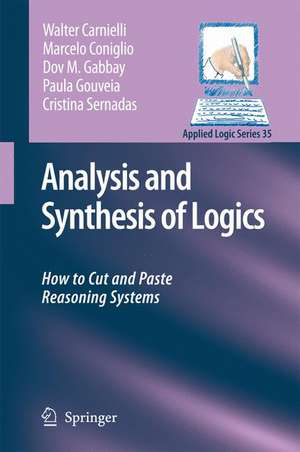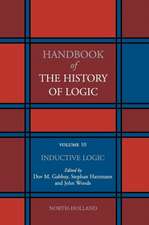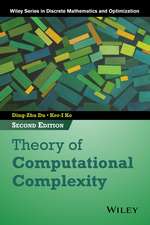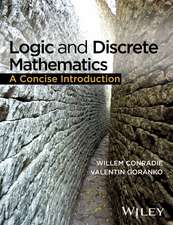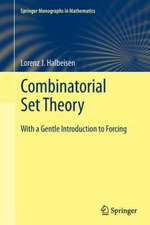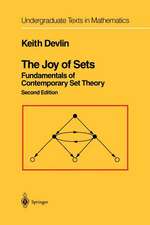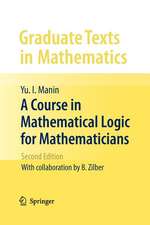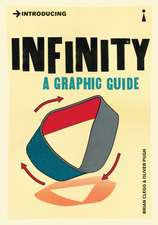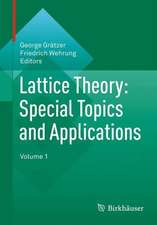Analysis and Synthesis of Logics: How to Cut and Paste Reasoning Systems: Applied Logic Series, cartea 35
Autor Walter Carnielli, Marcelo Coniglio, Dov M. Gabbay, Paula Gouveia, Cristina Sernadasen Limba Engleză Hardback – 4 feb 2008
The book brings the reader to the front line of current research in the field by showing both recent achievements and directions of future investigations (in particular, multiple open problems). It also provides examples of potential applications in emergent fields like security protocols, quantum computing, networks and argumentation theory, besides discussing more classical applications like software specification, knowledge representation, computational linguistics and modular automated reasoning.
This monograph will be of interest to researchers and graduate students in mathematical logic, theory of computation and philosophical logic with no previous knowledge of the subject of combining and decomposing logics, but with a working knowledge of first-order logic. The book will also be relevant for people involved in research projects where logic is used as a tool and the need for working with several logics at the same time is mandatory (for instance, temporal, epistemic and probabilistic logics).
| Toate formatele și edițiile | Preț | Express |
|---|---|---|
| Paperback (1) | 959.82 lei 6-8 săpt. | |
| SPRINGER NETHERLANDS – 22 noi 2010 | 959.82 lei 6-8 săpt. | |
| Hardback (1) | 966.15 lei 6-8 săpt. | |
| SPRINGER NETHERLANDS – 4 feb 2008 | 966.15 lei 6-8 săpt. |
Din seria Applied Logic Series
- 18%
 Preț: 1109.26 lei
Preț: 1109.26 lei - 20%
 Preț: 996.22 lei
Preț: 996.22 lei - 18%
 Preț: 957.13 lei
Preț: 957.13 lei - 15%
 Preț: 646.75 lei
Preț: 646.75 lei - 18%
 Preț: 1225.62 lei
Preț: 1225.62 lei - 18%
 Preț: 956.33 lei
Preț: 956.33 lei - 18%
 Preț: 957.44 lei
Preț: 957.44 lei - 18%
 Preț: 959.98 lei
Preț: 959.98 lei - 15%
 Preț: 639.73 lei
Preț: 639.73 lei - 18%
 Preț: 945.79 lei
Preț: 945.79 lei - 18%
 Preț: 949.55 lei
Preț: 949.55 lei - 18%
 Preț: 952.40 lei
Preț: 952.40 lei - 15%
 Preț: 637.13 lei
Preț: 637.13 lei - 15%
 Preț: 639.59 lei
Preț: 639.59 lei - 20%
 Preț: 1001.86 lei
Preț: 1001.86 lei - 15%
 Preț: 645.28 lei
Preț: 645.28 lei - 18%
 Preț: 957.32 lei
Preț: 957.32 lei - 15%
 Preț: 649.06 lei
Preț: 649.06 lei - 18%
 Preț: 953.20 lei
Preț: 953.20 lei - 15%
 Preț: 589.65 lei
Preț: 589.65 lei - 15%
 Preț: 648.74 lei
Preț: 648.74 lei - 18%
 Preț: 1117.99 lei
Preț: 1117.99 lei - 20%
 Preț: 338.03 lei
Preț: 338.03 lei - 18%
 Preț: 956.03 lei
Preț: 956.03 lei - 18%
 Preț: 953.65 lei
Preț: 953.65 lei
Preț: 966.15 lei
Preț vechi: 1178.23 lei
-18% Nou
Puncte Express: 1449
Preț estimativ în valută:
184.89€ • 200.77$ • 155.31£
184.89€ • 200.77$ • 155.31£
Carte tipărită la comandă
Livrare economică 22 aprilie-06 mai
Preluare comenzi: 021 569.72.76
Specificații
ISBN-13: 9781402067815
ISBN-10: 140206781X
Pagini: 620
Ilustrații: XVI, 602 p.
Dimensiuni: 156 x 235 x 39 mm
Greutate: 1.04 kg
Ediția:2008
Editura: SPRINGER NETHERLANDS
Colecția Springer
Seria Applied Logic Series
Locul publicării:Dordrecht, Netherlands
ISBN-10: 140206781X
Pagini: 620
Ilustrații: XVI, 602 p.
Dimensiuni: 156 x 235 x 39 mm
Greutate: 1.04 kg
Ediția:2008
Editura: SPRINGER NETHERLANDS
Colecția Springer
Seria Applied Logic Series
Locul publicării:Dordrecht, Netherlands
Public țintă
ResearchCuprins
Introductory overview.- Splicing logics: Syntactic fibring.- Splicing logics: Semantic fibring.- Heterogeneous fibring.- Fibring non-truth functional logics.- Fibring first-order logics.- Fibring higher-order logics.- Modulated fibring.- Splitting logics.- New trends: Network fibring.- Summing-up and outlook.
Recenzii
From the reviews:
“This is an advanced book on the combination of logics, which is a recent hot topic in logical research. The merit of the book is that it provides an overview of the scene, besides proving original theorems, in the scope of a general methodology for combination called fibring. … This book will be of interest to a large audience given that it also deals with applications of fibring in different areas.” (Alexandre Costa-Leite, Mathematical Reviews, Issue 2010 a)
“This is an advanced book on the combination of logics, which is a recent hot topic in logical research. The merit of the book is that it provides an overview of the scene, besides proving original theorems, in the scope of a general methodology for combination called fibring. … This book will be of interest to a large audience given that it also deals with applications of fibring in different areas.” (Alexandre Costa-Leite, Mathematical Reviews, Issue 2010 a)
Textul de pe ultima copertă
Starting with simple examples showing the relevance of cutting and pasting logics, the monograph develops a mathematical theory of combining and decomposing logics, ranging from propositional and first-order based logics to higher-order based logics as well as to non-truth functional logics. The theory covers mechanisms for combining semantic structures and deductive systems either of the same or different nature (for instance, two Hilbert calculi or a Hilbert calculus and a tableau calculus). The important issue of preservation of properties is extensively addressed. For instance, sufficient conditions are provided for a combined logic to be sound and complete when the original component logics are known to be sound and complete.
The book brings the reader to the front line of current research in the field by showing both recent achievements and directions of future investigations (in particular, multiple open problems). It also provides examples of potential applications in emergent fields like security protocols, quantum computing, networks and argumentation theory, besides discussing more classical applications like software specification, knowledge representation, computational linguistics and modular automated reasoning.
This monograph will be of interest to researchers and graduate students in mathematical logic, theory of computation and philosophical logic with no previous knowledge of the subject of combining and decomposing logics, but with a working knowledge of first-order logic. The book will also be relevant for people involved in research projects where logic is used as a tool and the need for working with several logics at the same time is mandatory (for instance, temporal, epistemic and probabilistic logics).
The book brings the reader to the front line of current research in the field by showing both recent achievements and directions of future investigations (in particular, multiple open problems). It also provides examples of potential applications in emergent fields like security protocols, quantum computing, networks and argumentation theory, besides discussing more classical applications like software specification, knowledge representation, computational linguistics and modular automated reasoning.
This monograph will be of interest to researchers and graduate students in mathematical logic, theory of computation and philosophical logic with no previous knowledge of the subject of combining and decomposing logics, but with a working knowledge of first-order logic. The book will also be relevant for people involved in research projects where logic is used as a tool and the need for working with several logics at the same time is mandatory (for instance, temporal, epistemic and probabilistic logics).
Caracteristici
First book addressing both composition and decomposition of logics Tool box for combining and decomposing logics in different guises Mathematical approach Several examples in such diverse areas as software specification, knowledge representation, argumentation theory, networks, security protocols and quantum computing Written by internationally leading researchers in the field of pure and applied logic and philosophy
